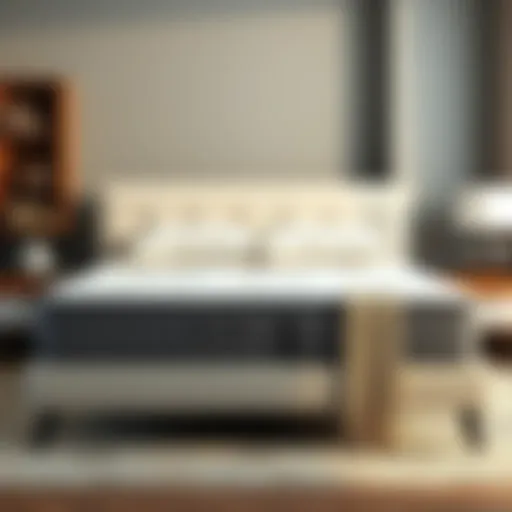In-Depth Analysis of Bed Prices in the Furniture Market
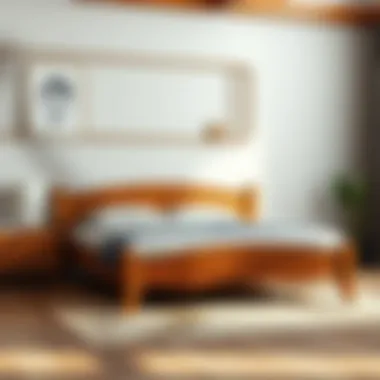
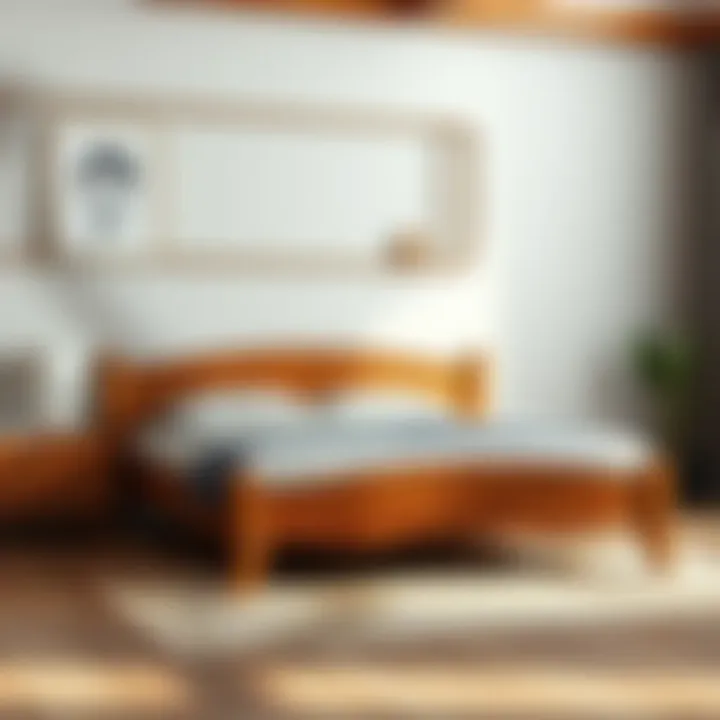
Intro
Navigating the world of bed prices can feel like stepping into a labyrinth without a map. From budget-friendly frames to high-end memory foam mattresses, the sheer variety can be dizzying. Yet, understanding what influences these prices is crucial for any homeowner, designer, or DIY enthusiast. In this analysis, we will break down the essential components that contribute to the cost of beds, help you discern value from fluff, and ensure you make choices that not only suit your wallet but also your aesthetic preferences.
Let's dig into what you're really paying for when it comes to beds—it's not just about the sticker price. You'll learn about different materials, design trends, and market fluctuations that play a significant role in determining bed costs. Ultimately, this guide aims to arm you with the knowledge to make informed decisions, aligning quality with budget without sacrificing style.
Furniture Design Trends
Current Styles and Aesthetics
In today’s marketplace, bed designs are as varied as the people who sleep in them. From sleek, minimalist frames that scream modern to ornately carved wooden canopies that bring an air of vintage elegance, the options go on and on. Some popular trends that have emerged recently include:
- Scandinavian Influence: Simple lines and functionality characterize this style. Light woods paired with neutral colors create a serene atmosphere.
- Industrial Vibes: Metal frames and raw materials lend an urban edge. This style often focuses on bold construction and exposed elements.
- Bohemian Bliss: Layers, textures, and vibrant colors define this eclectic approach. Often, beds might come adorned with unique tapestries and handmade accessories.
The aesthetic aspect is undeniably tied to price; higher design complexity often requires more skilled craftsmanship and quality materials, driving the overall cost.
Color Palettes and Materials
When it comes to color, today's trends tilt towards calming hues—think soft blues, earthy greens, and gentle grays. These shades evoke comfort and tranquility, inviting relaxation. Fabrics like linen and cotton remain popular for their breathability and ease of maintenance. However, don't discount traditional favorites like leather—though pricier, they offer durability and timeless appeal.
While solid woods like oak and cherry signal premium quality, engineered woods, which are more budget-friendly, are gaining traction. Understanding these material choices will not only help you gauge quality but will also clarify your spending.
"In furniture design, the choice of materials isn’t just about looks; it’s a conversation between cost, longevity, and aesthetic."
Buying Guides
Essential Considerations When Purchasing
Before diving into options, it’s wise to reflect on factors that influence your choice:
- Size: Measure your space! Sizes vary, and selecting one that fits well in your bedroom is crucial.
- Support: Think about whether you prefer a solid base or a box spring. This can affect both comfort and price.
- Lifestyle Needs: Different materials may cater better to allergies or temperature preferences.
Top Recommendations for Different Budgets
When it comes to investing in a bed, balancing quality with budget can feel like walking a tightrope. Here's a quick look at what you might find in various price ranges:
- Under $500: Basic upholstered beds, metal frames.
- $500 - $1,200: Mid-range options with better materials like solid wood or enhanced comfort features.
- Above $1,200: Luxury style beds, hybrids, or tailored designs that promise longer lifespans and superior craftsmanship.
End
In the intricate dance of bed pricing, knowledge is your best partner. With a clear understanding of current trends, materials, and pricing frameworks, you can shop confidently, ensuring that the bed you choose not only fits your budget but also enriches your living space. Remember: each detail counts, from the thread count to the timber, influencing both price and comfort.
Understanding Bed Pricing
When it comes to buying a bed, understanding the pricing can feel like navigating a maze. Sifting through countless options, brands, and designs, one must grasp what determines the cost. A bed is not just a piece of furniture; it’s an investment in comfort, health, and quality of sleep. Knowing how these elements intertwine can help consumers make smarter decisions, ensuring their choices align with their budgets and expectations.
The Market Dynamics
The bed market can be quite dynamic; it changes with consumer preferences, economic conditions, and even seasonal trends. During peak seasons, like back-to-school or holiday sales, prices might dip, offering great bargains. Conversely, certain styles may see price increases due to rising demand or limited supply. Companies often adjust prices based on market analysis, which reflects not just costs but also what consumers are willing to pay.
Factors Influencing Costs
The price of a bed is rarely straightforward, as it is influenced by various interconnected factors. Here’s a look at some of the driving forces behind bed pricing:
Materials and Construction
The choice of materials and the quality of construction play a pivotal role in determining the price of beds. For instance, solid wood frames can be sturdier and more durable compared to synthetic materials, which often cost less but may not last as long.
- Durability: Solid woods like oak or maple can resist wear and tear better than particle board.
- Comfort: High-density foam or memory foam mattresses tend to cost more due to their supportive properties.
- Sustainability: Eco-friendly materials are gaining traction, appealing to those seeking to reduce their carbon footprint.
However, while materials can elevate costs, they are a worthwhile investment for those valuing longevity and comfort.
Design Complexity
Design also plays a crucial role in bed pricing. Simple, minimalist designs typically cost less than intricately designed beds, which may feature detailed carvings or unique shapes.
- Visual Appeal: A stylish design can enhance a bedroom’s decor and add aesthetic value.
- Craftsmanship: Custom or handcrafted beds can demand higher prices due to the labor and skill involved.
Yet, prospective buyers need to balance aesthetics with practicality—sometimes a straightforward design is all that one truly needs.
Brand Reputation
Brand reputation significantly influences bed prices. Well-known brands with a strong reputation for quality may charge more than lesser-known or private labels. Established brands often have a loyal customer base, allowing them to maintain higher prices.
- Warranty and Support: Recognized brands usually offer better warranties and customer service.
- Trust Factor: Consumers are often willing to pay a premium for what they perceive as guaranteed quality.


However, it’s essential to scrutinize what truly justifies the higher price tag, as not all well-known brands deliver equal value.
Market Trends
Finally, evolving market trends can impact bed pricing significantly. As styles change and consumer preferences shift, manufacturers must adapt. For instance, the growing interest in adjustable beds has led to innovations, pushing up prices but also providing more options for customization.
- Innovation: Features like built-in massage or sleep tracking can hike prices, but they also add significant value.
- Cultural Shifts: An increase in remote work has sparked demand for home office beds, influencing styles and pricing.
Consumers should keep an eye on these trends, as understanding the market can help identify value for money.
"Price isn't everything, but it's a major slice of the pie when choosing the right bed."
In summary, grasping the basics of bed pricing involves looking beyond mere numbers. It requires an appreciation for the intricate dance of materials, design, brand, and market trends. Happily, when armed with this knowledge, buyers can navigate the bed-buying process with confidence.
Types of Beds and Their Price Ranges
Understanding different types of beds and their corresponding price ranges is fundamental in making an informed buying decision. Each bed type comes with its own unique features, styles, and functional benefits that cater to varying needs and preferences. Whether you're redecorating a bedroom or furnishing a new apartment, knowing where a particular type of bed stands in terms of pricing will assist in aligning your aesthetic desires with your budgetary capabilities. This section takes a closer look at the types of beds available in the market and how their prices can differ dramatically based on various factors.
Platform Beds
Price Range Overview
Platform beds have grown in popularity, particularly for their sleek, minimalist appearance and sturdy structure. The price of these beds typically ranges from $200 to $2,000, depending on features and material quality. This variety provides options for both budget-conscious consumers and those willing to invest in a high-end piece. These beds are usually constructed from solid wood or metal, which significantly affects their pricing. While a basic model may suffice for a starter home, a premium model with additional features can transform your sleep space into a luxurious retreat. Their straightforward designs also make them a popular choice among consumers looking to maximize their bedroom's visual appeal.
Popular Styles
When it comes to platform beds, styles can vary widely, which contributes to their diverse pricing. Some design trends emphasize low profiles and clean lines, while others incorporate upholstered headboards or intricate detailing. For example, a simple wooden platform bed may cost less, while a plush, upholstered model with a tufted headboard can reach the upper pricing spectrum. The choice of style influences not only the aesthetic but also the overall comfort level. A well-designed platform bed often becomes the centerpiece of the bedroom, making the right style selection vital. Therefore, investing time in selecting a style that reflects your personal taste is key.
Material Considerations
Materials play a pivotal role in the pricing of platform beds. Solid hardwoods like oak or maple typically result in a more expensive product due to their durability and timeless appeal. In contrast, cheaper materials, like particleboard, offer a budget-friendly option but compromise on longevity. A platform bed made from responsibly sourced wood can position itself as an environmentally conscious choice for the discerning consumer while also enhancing bedroom aesthetics. It's important to evaluate the trade-offs between cost and quality, since a sound investment in materials often translates to longer-lasting comfort and satisfaction.
Storage Beds
Functional Design
Storage beds are designed to maximize space, making them an ideal choice for smaller bedrooms. This type of bed offers built-in storage options, such as drawers or lift-top compartments, to help keep the space organized. Prices typically range from $400 to $3,500, depending on the design complexity and materials used. These beds are not only practical but also contribute to a clutter-free environment, which can positively impact your living space. In particularly small apartments or guest rooms, storage beds can provide much-needed additional space without compromising on comfort or style.
Average Cost
A major consideration with storage beds is their average cost. While some entry-level models can start around $400, higher-end options often reach several thousand dollars due to luxurious materials and advanced features. For homeowners seeking both style and functionality, the investment may seem justified upon seeing the effective use of space these beds facilitate. Combining aesthetics with practical utility, a storage bed can offer a holistic solution for modern living, especially in urban contexts where space is at a premium.
Material Variations
The materials used in storage beds can vary significantly, contributing to both their cost and performance. Wooden frames are common, but metal constructions are also popular for their durability and clean look. Some designs feature composite materials, which can lower costs while still providing fair stability. Consumers must weigh the pros and cons of materials carefully; while cheaper options might save you money upfront, they may not provide the longevity that higher-quality materials offer. It's often recommended to consider a material that balances cost with durability for a wise purchase.
Adjustable Beds
Features and Pricing
Adjustable beds have become widely popular due to their customizable comfort options. They generally range from $600 to $4,000. The investment often hinges on features such as massage functions, remote controls, and customizable support settings. Homeowners who appreciate getting a good night's sleep tend to lean towards adjustable beds, as they can help alleviate certain sleep-related conditions. Whether you're looking to find that just-right incline for reading or need an elevated position for health reasons, adjustable beds can cater to individual preferences.
Market Offerings
There are various market offerings when it comes to adjustable beds. Several brands produce models with various feature sets, and consumers frequently share insights through online reviews. It's worth noting that more features typically come at a higher price. Researching these options can ensure that you’re well informed about your choices, along with the corresponding costs. A thorough understanding of features empowers consumers to select a bed that aligns with their lifestyle and health requirements.
Consumer Feedback
Consumer feedback is invaluable when purchasing adjustable beds. Many users highlight comfort and the potential for better sleep quality as key advantages. On the flip side, some point out the higher price tags or potential issues with assembly. Many appreciate adjustable beds for their versatility but may also express hesitations based on price or complexity of use. Before committing, it's wise to consult reviews and ratings for specific models, giving you a clear direction on which brands or styles to favor based on real consumer experiences.
Sleigh Beds
Classic Design Elements
Sleigh beds are celebrated for their classic elegance and timeless appeal. Characterized by curved or scrolled headboards and footboards, they evoke a sense of sophistication that can enhance any bedroom setting. Prices range from $500 to over $3,000, influenced by design intricacies and material quality. Many consumers find the distinction in craftsmanship particularly appealing, adding a touch of artistry to their sleeping space. The intricate design can often serve as a focal point, helping connect various decor elements in a room.
Cost Analysis
Analyzing the costs associated with sleigh beds reveals a range of factors contributing to price deviations. For instance, handcrafted or solid wood options command a higher price due to their labor and materials, while mass-produced versions can be more cost-effective. While it is tempting to choose an affordable option, opting for quality can lead to a piece that withstands the test of time aesthetically and structurally. A keen eye for craftsmanship can lead to a satisfying investment.
Material Quality
The quality of materials used in sleigh beds can vary significantly. Solid wood is often favored for its durability and aesthetic appeal, but there are many less expensive materials as well. As a result, potential buyers must consider the long-term implications of their material choice, weighing factors like stability and maintenance needs against their initial financial outlay. Choosing a high-quality sleigh bed often comes with the added benefit of enhanced resale value, should you decide to upgrade in the future.
Bunk Beds
Target Demographic


Bunk beds are especially popular among families, dormitories, and hostels, designed to maximize sleeping arrangements while minimizing space usage. Generally appealing to children, teens, and young adults, their versatility makes them a unique option among bed types. Priced between $200 and $1,500, they come in various designs suitable for multiple contexts, from children's rooms to guest houses.
Price Variability
There is quite a bit of price variability with bunk beds, often determined by factors such as size, material, and additional features like built-in storage or trundle beds. Basic models may be surprisingly affordable, while higher-end options that offer both comfort and style can reach higher price points. It's critical to consider the purpose and longevity of your investment, and to balance cost with functionality and aesthetics, especially if the bed is for everyday use.
Safety and Quality Considerations
When evaluating bunk beds, safety is paramount. Quality construction and reliable materials are essential in ensuring that the bed can support user weight and withstand the rigors of daily use. Consumers should pay close attention to weight limits, guardrails, and ladders, as these factors can significantly influence safety outcomes. Additionally, considering certifications may help buyers identify safer and more reliable choices, emphasizing the importance of integrating safety with quality in choosing a bunk bed.
Budget Considerations When Purchasing Beds
When it comes down to picking the right bed, budget plays a crucial role in the decision-making process. After all, beds are not a small investment. The balance between quality, aesthetics, and price can sometimes make your head spin. It’s essential to understand how to approach your budget wisely, ensuring you end up with a bed that meets both your financial and comfort expectations.
Setting a Realistic Budget
Establishing a realistic budget is your first step toward making an informed purchase. It's easy to underestimate the costs associated with buying a bed because, let's face it, it's more than just the piece of furniture. You ought to consider:
- Additional items: Mattresses, bed frames, bedding, and even delivery charges.
- Quality goals: Aim to find a sweet spot where price meets the durability and comfort of the bed.
- Timeframe: If you have a specific deadline for when you need a new bed, factor this into your purchasing decisions.
When setting your budget, it's helpful to take a comprehensive look at your overall finances. Monitoring your outgoings can give you a clearer picture of how much you're willing to spend. It’s beneficial not to disregard the importance of comfort—after all, sleep is an essential part of health!
High-Quality vs. Cost-Effective Options
As you navigate through bed options, you'll discover a striking divide between high-quality and cost-effective choices. It's tempting to gravitate toward low-priced items, especially if you're on a tighter budget, but consider the long-term implications:
- Longevity: High-quality beds will often outlast their cheaper counterparts. A bed that retains its shape and support over the years can lead to overall cost savings.
- Comfort: Springing for a better-quality bed often means enhanced comfort, which directly affects your sleep quality.
However, it's entirely possible to find budget-friendly options that don't skimp on quality. Research and read up on consumer feedback regarding various brands. Furthermore, keep an eye on materials; sometimes, a switch in fabric or construction methods can save a pretty penny.
Sale Periods and Discounts
Savvy shoppers know that timing can make a world of difference when it comes to bed prices. Sale periods offer opportunities to snag quality beds at a fraction of the regular price. Major holidays often include sales, and so do seasonal transitions—think spring cleaning or back-to-school promotions. Here are a few strategies:
- Watch for clearance sales: Retailers frequently discount older inventory to make room for new arrivals.
- Sign up for newsletters: Many stores will offer exclusive deals to subscribers, keeping you in the loop on special discounts.
- Look for price matching policies: Some stores may match or beat competitors' prices, which can also lead to savings.
"A well-timed purchase can save you bucks while landing a quality piece. Do your homework!"
In summation, budgeting for a bed calls for a good eye on quality and the grace to know when to splurge or save. By setting a realistic budget, weighing the pros and cons of high-quality and cost-effective options, and taking advantage of sale periods, you build a foundation for a wise investment that caters to your needs.
Evaluating Quality Against Price
When purchasing a bed, the intersection between quality and price stands as a crucial point of consideration. It is essential to understand that cheaper options often come with compromises—be it in build quality, longevity, or even comfort. Thus, evaluating quality against price is not merely an exercise in budgeting; it directly influences the long-term satisfaction of one’s investment. A bed isn’t just a piece of furniture—it can affect your health, sleep quality, and overall well-being. Hence, discerning the nuances between various options becomes imperative.
A low upfront cost can be enticing, but potential hidden costs arise when quality is sacrificed for price. For instance, a cheaper mattress might result in increased discomfort and poor sleep, leading to health issues in the long run. Conversely, investing in a moderately expensive bed crafted from high-quality materials can be seen as a long-term saving strategy, reducing the frequency of replacements and repairs. When making your selection, here are several crucial elements to assess:
- Material Grade: This can significantly influence both comfort and durability. Higher-grade materials often carry a steeper price, yet they may also offer less wear over time.
- Construction Quality: The craftsmanship involved can reflect in both aesthetic appeal and functional stability. Look for standout elements that indicate better construction, like robust joints and finishes.
- Comfort Features: Consider whether a bed comes equipped with ergonomic designs or technologies. This can range from memory foam layers to customizable firmness settings.
Making informed decisions about quality and price can ensure that homeowners, designers, and DIY enthusiasts find the balance they seek, leading to choices that enhance their living space without breaking the bank.
Durability and Material Choice
Durability is often the most overlooked factor when analyzing a bed's price. The longevity of a bed hinges on the quality of materials used. Various materials, such as solid wood, metal frames, and composite materials, each have their own pros and cons.
- Wooden Beds: Solid hardwood such as oak or maple generally offers high durability and a timeless aesthetic, but they often come at a higher cost. Meanwhile, particle board or lower-quality wood can seem attractive for their price but lacks longevity.
- Metal Frames: These tend to be less expensive and more durable against wear, but their aesthetic may not cater to everyone's taste. However, modern designs have made metal beds more visually appealing.
- Upholstery Choices: Fabrics used in headboards and frames impact both comfort and maintenance. Natural textiles may require more upkeep as compared to synthetic materials, which can be more resistant to stains and wear.
Investing time to understand material differences can steer you toward a smarter buying decision that echoes well beyond immediate comfort.
Brand Reliability
Brand reliability plays a notable role in the perceived value of a bed. Familiar brands like Tempur-Pedic or Sealy carry decades of reputation, which often correlates with quality assurance. When evaluating quality against price, it’s prudent to consider how different brands position themselves in the market.
- Customer Reviews: Platforms like Reddit or specialized sites provide a wealth of information on customer experiences. They can inform potential buyers about real-world durability and comfort levels, revealing insights that flashy marketing might gloss over.
- Transparency in Manufacturing: Brands that are open about their materials and production processes often inspire more confidence. This transparency can be a red flag for cheaper brands that are less forthcoming about their construction.
- Warranty and Return Policies: Recognized brands often back their products with solid warranties, providing peace of mind. On the flip side, sound policies can hint at poor manufacturing practices when associated with lesser-known brands.
Sustainability and Ethical Pricing
When delving into the realm of bed prices, it's crucial to shine a spotlight on sustainability and ethical pricing. Today’s consumers are increasingly aware of the environmental footprints left by their purchases. In the burgeoning market of eco-conscious products, knowing what goes into the making of a bed not only helps in making choices that align with personal values but also contributes to a larger movement towards responsible consumption.
Sustainability in bed pricing encapsulates several factors, all revolving around the eco-friendly practices of manufacturers. Choosing sustainable options often means a bit of an investment upfront, but this can lead to long-term benefits both for the planet and your wallet.
Eco-Friendly Materials
In the bed market, eco-friendly materials have gained prominence. Among these, bamboo stands out for its rapid growth and minimal resource requirement. All it needs is sunlight and rain, which makes it a sustainable option. Likewise, organic cotton is grown without harmful pesticides and synthetic fertilizers, ensuring that the production process is less taxing on the environment.
Here are some common eco-friendly materials:
- Bamboo: Fast-growing and biodegradable, it's often used in bed frames and linens.
- Recycled Plastic: Some companies transform single-use plastics into durable mattress components.
- Natural Latex: Sourced from rubber trees, this material is biodegradable and has minimal environmental impact.
- Hemp: Another sustainable option, it requires less water compared to conventional cotton, making it an excellent choice for bedding.
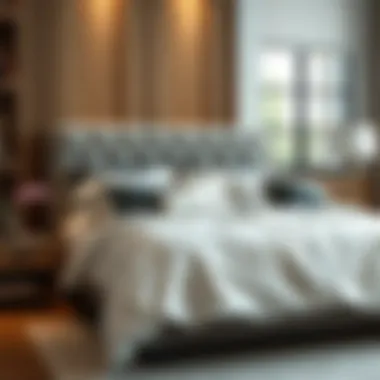
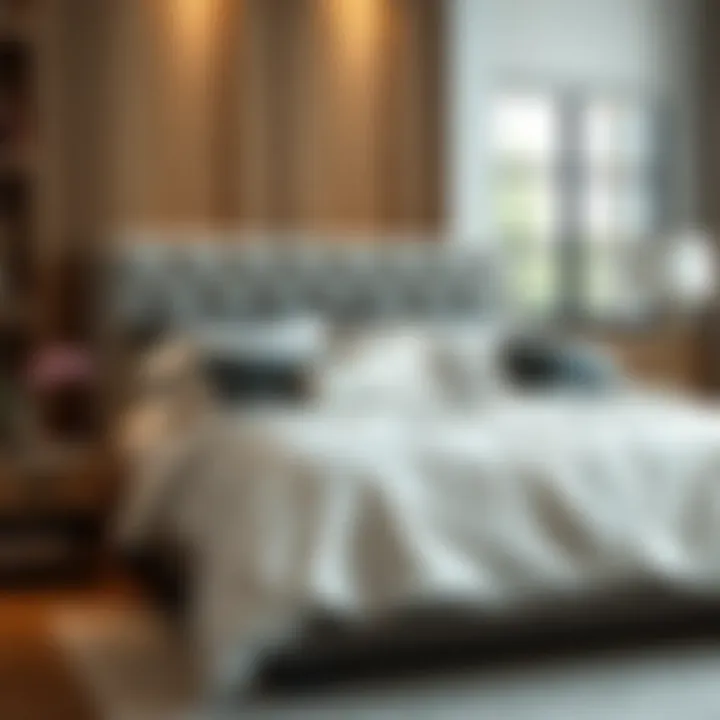
Beyond the choice of materials, consumers should consider certifications like Global Organic Textile Standard (GOTS) or Forest Stewardship Council (FSC). These labels often indicate a product is manufactured with attention to environmental and social sustainability.
Manufacturing Practices
The manufacturing practices of bed producers play an equally vital role in determining sustainability and ethical pricing. It’s not just about what materials are used but also how the entire production process is structured. Many brands are now seeing the value in harnessing renewable energy sources, such as solar or wind, to power their factories.
When selecting a bed, consider the following:
- Local Sourcing: Beds made with locally sourced materials reduce transportation emissions and support local economies.
- Fair Labor Practices: Ethics extend to the workforce as well. Brands that adhere to fair labor practices often pay workers a livable wage and adhere to safe working conditions.
- Waste Reduction: Some companies take extra steps to minimize waste by reusing offcuts and maintaining efficient manufacturing processes.
"When you purchase furniture produced sustainably, you're not merely investing in a product; you're casting a vote for the kind of world you want to live in."
Incorporating sustainable practices in bed manufacturing provides a holistic approach to pricing; it reflects not just the quality of materials but also the integrity of the processes involved. Homeowners, designers, and DIY enthusiasts who prioritize sustainability can feel assured that they are making well-informed choices that positively impact the environment.
Trends Impacting Bed Prices
When it comes to buying a bed, the pricing landscape is ever-shifting. Understanding the trends that affect these costs can equip homeowners, designers, and DIY enthusiasts alike with the savvy needed to navigate this marketplace effectively. After all, who doesn’t want to get the best bang for their buck? Keeping an eye on these trends not only helps with budgeting but also improves overall purchasing satisfaction.
Material Innovations
Recent years have seen a flurry of material innovations in bed design, and these advancements often play a key role in pricing. For instance, the use of memory foam, initially a luxury item, is now more widely available, leading to a drop in its price. But it’s not just about the foam.
- Hybrid Models: These are catching on like wildfire. Combining innerspring coils with foam not only enhances comfort but also caters to various preferences—which can affect pricing.
- Sustainable Materials: Eco-friendly options such as bamboo, organic cotton, and recycled materials are not just a trend; they’re becoming essential. With rising awareness about sustainability, beds crafted from these materials may hold higher price tags due to their sourcing.
- Technological Enhancements: Beds with features like adjustable bases, temperature regulation, and smart technology tend to cost more. This is because consumers are willing to invest in comfort and convenience, driving prices upward.
As these innovations continue to roll out, the landscape is likely to shift, often resulting in a greater variety of price points to consider.
Consumer Preferences
Another significant influencer in the pricing game is consumer preferences. As tastes evolve and marketplaces adapt, the cost of beds adjusts accordingly. Here are some notable shifts:
- Customization: There's a growing trend towards personalization, where customers want beds tailored to their individual needs. This customization can transform a standard bed into a bespoke piece, often leading to higher prices.
- Minimalism: A rise in minimalistic living has prompted consumers to opt for simpler designs. While some may see a drop in costs due to less material being used, unique minimalist designs can also drive prices up if they come from boutique brands.
- Brand Loyalty: Certain brands have cultivated a loyal consumer base by emphasizing quality and specialized design. beds from well-known brands may carry higher price tags, reflecting both their reputation and perceived value.
In summary, the market dynamically shifts in response to consumer desires and innovations. It's essential to stay informed about these elements to make wise purchasing decisions. Don't forget, a deep dive into these trends not only illuminates potential costs but also enriches one's understanding of what options are available in today's furniture market.
Practical Tips for Buying Beds
When it comes to investing in a bed, knowledge is power. Buying the right bed is not just about picking a pretty frame or a plush mattress. It’s about ensuring that you make a decision that serves your comfort, health, and aesthetics. With myriad options available, practical tips become essential in navigating the bustling bed market effectively. Neglecting these can lead to a purchase you'll regret down the line, not to mention a hit to your wallet.
Connecting the various threads of bed buying, practical tips can help clarify your priorities while making this crucial choice. The right bed can considerably impact your quality of sleep and, consequently, your overall well-being. Moreover, understanding what to look for could potentially save you from rash purchases that don't align with your needs or budget.
Researching Options
First things first, knowledge is crucial. A dive into the sea of options can be overwhelming, but it’s necessary. Start by narrowing down what you specifically need. Are you seeking a sleek design that complements your room, or do you need something more functional, like a storage bed, to manage space efficiently?
Here are some key considerations when researching:
- Identify your needs: Figure out what’s non-negotiable for you. This could be size, style, mattress type, or special features like adjustability or built-in storage.
- Examine materials: Different materials provide different levels of durability and comfort. Solid wood beds, for instance, might be sturdier compared to particleboard options but often come at a higher price.
- Look at customer reviews: Don’t just skim the product details; check what people are saying. Actual user experiences can provide insights into durability and comfort that specifications might gloss over.
- Visit stores: Online shopping is convenient, but nothing compares to physically testing a bed. Lay down, even if just for a minute, and see how each one feels.
Research helps in establishing a solid groundwork from which to make your final decision. You wouldn’t buy a car without test driving it, so why treat beds differently?
Testing for Comfort
Comfort is personal and subjective. What works for one person may not resonate with another. This is why testing for comfort cannot be ignored when buying a bed. If possible, try to visit stores that allow you to experience various beds.
When you’re trying out a bed, consider the following:
- Sleep Position: Your preferred sleeping position influences what feels comfortable. A side sleeper may benefit from a softer mattress that cradles their shoulders and hips, while a back sleeper might need a firmer mattress for proper spinal alignment.
- Support and Pressure Relief: Pay attention to the support a bed provides. Press down on different areas; make sure there are no pressure points that would cause discomfort later during the night.
- Mattress Materials: Different mattresses—like memory foam, latex, or innerspring—have unique feels to them. Each material has a different level of bounce or sinking, which can greatly affect comfort.
- Durability Considerations: Often, comfort can also indicate durability. If a mattress is already sagging after a few minutes, it might not last long-term.
A bed shouldn’t just look good; it should feel good too.
While sifting through beds, prioritize what you feel is right. The bed is an investment, so ensuring you get one that aligns with your preferences will be worth it in the long run.
With these practical tips firmly in mind, buyers can approach the bed market more confidently, making not just an informed choice, but a truly personal one.
Epilogue
As we draw the curtains on our exploration of bed pricing, it’s crucial to reflect on the significant elements that shape our understanding of this market. The importance of comprehending bed pricing isn't merely an exercise in curiosity—it directly influences our purchasing decisions, our comfort, and ultimately, our daily lives. A poor choice in bed selection can lead to sleepless nights and even affect one’s overall health, while a well-informed decision can transform a simple bedroom into a sanctuary of rest.
In a world where options abound, recognizing the nuances of cost versus quality is paramount. Consumers must navigate through a maze of materials, styles, and price points. An understanding of the factors that influence bed prices—such as manufacturing processes, materials, and market trends—empowers individuals to discern what aligns with their preferences and budget.
Among the diverse bed types, from platform beds to adjustable frames, knowing what each offers in terms of functionality and design is invaluable. This concludes not just in knowledge but also in practical decision-making. By weighing options carefully, you can prioritize features like durability or design that are crucial for your lifestyle.
Furthermore, keeping an ear to the ground about sales periods and discounts can enable savvy purchases without compromising on quality.
“Knowledge is power,” as they say, holds true in the realm of bed shopping. Understanding how to balance budget, style, and quality can result in choices that not only meet your needs but also exceed your expectations.
Ultimately, the right bed should not just serve as a place to lay your head; it should reflect your unique taste, provide comfort, and support your well-being. As you move forward, allow this knowledge to guide you on a journey toward finding the ideal bed that promises restful nights ahead—because a well-rested mind is an asset you cannot undervalue.
Final Thoughts on Bed Pricing
Considering the broad spectrum of factors at play—from sustainability to design innovations—it’s clear that bed pricing is not a straightforward topic. Each choice carries weight, from the environmentally conscious materials to the brand’s reputation. The insights gathered throughout this analysis highlight the overarching trend that savvy consumers can dive into the complexities of bed pricing, empowered by knowledge.
Ultimately, regardless of style preferences or budget constraints, embracing a well-rounded approach to bed purchasing can lead to significant long-term benefits. Therefore, as you embark on this undertaking, remember that the best decisions come from fully informed perspectives, ensuring that the bed you choose becomes a worthy investment in your comfort and health.



